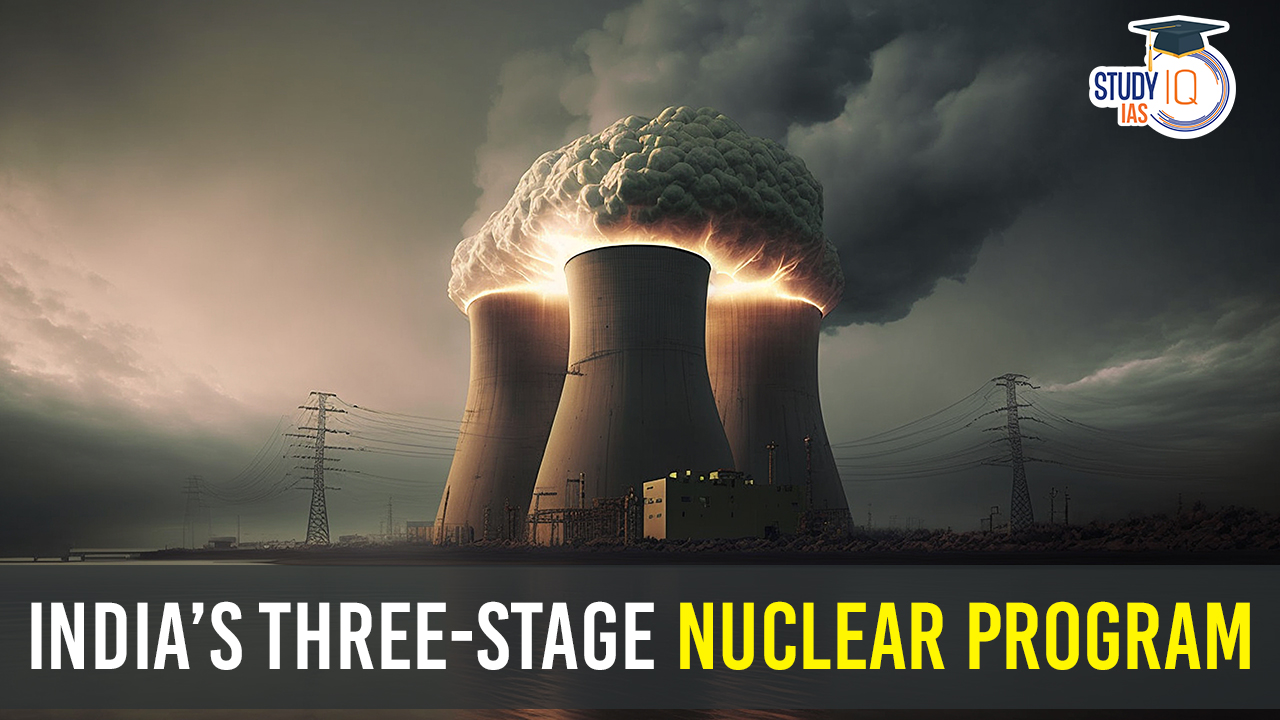Table of Contents
India’s Three-stage Nuclear Program, also known as the Three-Stage Nuclear Power Program or the Thorian Program, is a long-term nuclear energy strategy that was initially developed by Dr. Homi J. Bhabha, the father of India’s nuclear program. The program is designed to utilize India’s vast thorium reserves and achieve energy independence.
We’re now on WhatsApp. Click to Join
Three-Stage Nuclear Program of India
India’s commitment to nuclear energy as a sustainable resource dates back to the inception of its atomic energy program over four decades ago. At that time, India devised a comprehensive three-stage nuclear power program founded on a closed nuclear fuel cycle. This program is characterized by the following stages:
- Pressurized Heavy Water Reactors (PHWRs) with Natural Uranium Fuel
- Fast Breeder Reactors (FBRs) Employing Plutonium-Based Fuel
- Advanced Nuclear Power Systems for Thorium Utilization
Pressurized Heavy Water Reactors (PHWRs)
Pressurized Heavy Water Reactors (PHWRs) are a type of nuclear reactor that use natural uranium as fuel and heavy water (deuterium oxide) as both a moderator and coolant. They are a vital component of India’s three-stage nuclear program. PHWRs are known for their safety and reliability. They generate electricity and produce plutonium-239 as a byproduct, which can be used for fuel in subsequent stages. India has successfully operated PHWRs to meet its energy needs, marking the first stage of its nuclear program.
| Pressurized Heavy Water Reactors (PHWRs) | Role in India’s Nuclear Program | Key Features | |
| Role | First stage of India’s nuclear program | Generate electricity, produce plutonium-239 as a byproduct | |
| Fuel | Natural uranium | Utilize natural uranium as fuel | |
| Moderator/Coolant | Heavy water (deuterium oxide) | Use heavy water as both a moderator and coolant | |
| Safety and Reliability | Known for their safety and reliability | Proven track record in meeting India’s energy needs | |
| Reactor Type | Fuel Used | By-Product | Rationale/Advantages |
| Boiling Water Reactor (BWR) | Natural Uranium | Plutonium-239 | Efficient uranium utilization in the 1960s |
| Pressurized Heavy Water Reactor (PHWR) | Natural Uranium | Plutonium-239 | Efficient uranium utilization; heavy water production |
| Pressurized Water Reactor (PWR) | Natural Uranium | Plutonium-239 | Efficient uranium utilization; local component production |
Fast Breeder Reactors (FBRs)
Fast Breeder Reactors (FBRs) are advanced nuclear reactors designed to produce more fissile material than they consume. They use plutonium-based fuel and are a critical part of India’s second stage in the nuclear program. FBRs play a pivotal role in maximizing nuclear resource utilization, as they breed additional fissile materials like plutonium-239 and uranium-233. This surplus fissile material can be used to fuel other reactors, enhancing energy self-sufficiency and reducing nuclear waste.
| Fast Breeder Reactors (FBRs) | Purpose/Role | Key Features |
| Purpose | Produce more fissile material than they consume | Maximize nuclear resource utilization, breed additional fissile materials (Pu-239, U-233) |
| Fuel | Plutonium-based fuel | Utilize plutonium-based fuel, create surplus fissile material |
| Benefits | Enhanced resource utilization, energy self-sufficiency | Produce surplus fissile material for use in other reactors, reduce nuclear waste |
Advanced Heavy Water Reactors (AHWRs)
Advanced Heavy Water Reactors (AHWRs) represent the third stage in India’s nuclear program. They are designed to use thorium as the primary fuel source, with uranium-233 bred from thorium serving as the fissile material. Thorium is abundant in India, and AHWRs aim to harness this resource to achieve long-term energy sustainability. These reactors offer the promise of clean and sustainable energy production, as thorium is less susceptible to proliferation risks and produces minimal long-lived radioactive waste. AHWRs are a key component of India’s efforts to secure its energy future.
| Advanced Heavy Water Reactors (AHWRs) | Purpose/Role | Key Features |
| Purpose | Utilize thorium as the primary fuel source | Achieve long-term energy sustainability, harness India’s abundant thorium resources |
| Fuel | Thorium with uranium-233 as the fissile material | Thorium-based fuel, uranium-233 bred from thorium, lower proliferation risks, minimal waste |
| Benefits | Clean and sustainable energy production | Less proliferation risks, reduced long-lived radioactive waste, securing India’s energy future |
Advanced Heavy Water Reactors (AHWRs) Benefits
Advanced Heavy Water Reactors (AHWRs) offer numerous advantages:
- Utilize thorium for long-term energy sustainability
- Lower proliferation risk due to reduced weapons-grade material
- Minimize long-lived radioactive waste, simplifying disposal
- Enhanced safety features, lower operating pressures
- Fuel flexibility with potential resource optimization
- Improved energy security by reducing dependence on imports
- Environmentally friendly with low greenhouse gas emissions
- Adaptability to existing nuclear infrastructure
- Integral to India’s Three-Stage Nuclear Program
- Opportunities for scientific research and innovation.
List Of Nuclear Reactors in India
In India, nuclear power stands as the fifth-largest contributor to energy production, following coal, gas, wind, and hydroelectricity. The country currently operates 22 nuclear reactors with a combined installed capacity of approximately 6,780 MW. India’s journey into nuclear energy began under the leadership of Homi J. Bhabha during the period of independence.
Asia’s inaugural nuclear power plant, the Apsara Research Reactor, is situated in Mumbai. Despite having limited indigenous uranium resources, India relies on importing uranium from other countries to fuel its nuclear power sector. Russia has been a primary supplier of nuclear fuel for India since the 1990s.
| Operational Nuclear Power Plants in India | ||||
| Sr. No. | Plant Name | Date of Commercial Operation | Location | Gross Power (MWe) |
| 1 | Tarapur Atomic Power Plant-1 (TAPS-1) | Oct-1969 | Boisar, Maharashtra | 160 |
| 2 | Tarapur Atomic Power Plant-2 (TAPS-2) | Oct-1969 | Boisar, Maharashtra | 160 |
| 3 | Rajasthan Atomic Power Plant-1 (RAPS-1) | Dec-1973 | Kota, Rajasthan | 100 |
| 4 | Rajasthan Atomic Power Plant-2 (RAPS-2) | Apr-1981 | Kota, Rajasthan | 200 |
| 5 | Madras Atomic Power Plant-1 (MAPS-1) | Jan-1984 | Kalpakkam, Tamil Nadu | 220 |
| 6 | Madras Atomic Power Plant-2 (MAPS-2) | Mar-1986 | Kalpakkam, Tamil Nadu | 220 |
| 7 | Narora Atomic Power Plant-1 (NAPS-1) | Jan-1991 | Narora, Uttar Pradesh | 220 |
| 8 | Narora Atomic Power Plant-2 (NAPS-2) | Jul-1992 | Narora, Uttar Pradesh | 220 |
| 9 | Kakrapar Atomic Power Plant-1 (KAPS-1) | May-1993 | Tapi, Gujarat | 220 |
| 10 | Kakrapar Atomic Power Plant-2 (KAPS-2) | Sep-1995 | Tapi, Gujarat | 220 |
| 11 | Kaiga Generating Station-1 (KGS-1) | Nov-2000 | Kaiga, Karnataka | 220 |
| 12 | Kaiga Generating Station-2 (KGS-2) | Mar-2000 | Kaiga, Karnataka | 220 |
| 13 | Rajasthan Atomic Power Plant-3 (RAPS-3) | Jun-2000 | Kota, Rajasthan | 220 |
| 14 | Rajasthan Atomic Power Plant-4 (RAPS-4) | Dec-2000 | Kota, Rajasthan | 220 |
| 15 | Kaiga Generating Station-3 (KGS-3) | May-2007 | Kaiga, Karnataka | 220 |
| 16 | Kaiga Generating Station-4 (KGS-4) | Jan-2011 | Kaiga, Karnataka | 220 |
| 17 | Tarapur Atomic Power Plant-3 (TAPS-3) | Aug-2006 | Boisar, Maharashtra | 540 |
| 18 | Tarapur Atomic Power Plant-4 (TAPS-4) | Sep-2005 | Boisar, Maharashtra | 540 |
| 19 | Rajasthan Atomic Power Plant-5 (RAPS-5) | Feb-2010 | Kota, Rajasthan | 220 |
| 20 | Rajasthan Atomic Power Plant-6 (RAPS-6) | Mar-2010 | Kota, Rajasthan | 220 |
| 21 | Kudankulam Nuclear Power Station-1 (KKNPS-1) | Dec-2014 | Kudankulam, Tamil Nadu | 1000 |
| 22 | Kudankulam Nuclear Power Station-2 (KKNPS-2) | Mar-2017 | Kudankulam, Tamil Nadu | 1000 |
| Nuclear Power Plants Under Construction | |||
|
Name of Nuclear Power Station |
Location | Operator | Capacity (MWe) |
| Madras (Kalpakkam) | Tamil Nadu | BHAVINI | 500 |
| Rajasthan Unit 7 and 8 | Rajasthan | NPCIL | 1,400 |
| Kakrapar Unit 3 and 4 | Gujarat | NPCIL | 1,400 |
| Kudankulam Unit 3 and 4 | Tamil Nadu | NPCIL | 2,000 |
Benefits of Thorium Technology
Thorium technology, specifically thorium-based nuclear reactors, offers several potential benefits, although it is still in the research and development stage. Some of the advantages of thorium technology include:
- Abundant Fuel Supply: Thorium is more abundant in nature than uranium, and it can be found in various countries, reducing dependence on limited uranium resources. India, for example, has substantial thorium reserves.
- Reduced Nuclear Proliferation Risk: Thorium fuel cycles can potentially produce fewer weapons-grade materials compared to uranium fuel cycles, making them less susceptible to nuclear weapons proliferation.
- Enhanced Safety: Thorium reactors can be designed to operate at lower pressures and temperatures, which can contribute to enhanced safety features and reduced risks of catastrophic accidents.
- Reduced Long-Lived Nuclear Waste: Thorium-based reactors can produce significantly less long-lived radioactive waste compared to uranium reactors, simplifying waste management and disposal.
- Improved Fuel Utilization: Thorium fuel has the potential for more efficient utilization of nuclear fuel, with a higher percentage of fissile material consumed during the fission process.
- Inherent Inherent Safety Features: Many thorium reactor designs have inherent safety features that make them more stable and less prone to catastrophic failure.
- Energy Security: For countries with significant thorium resources, thorium technology can provide a more secure and sustainable energy source, reducing reliance on fossil fuels and imported uranium.
- Reduced Greenhouse Gas Emissions: Thorium reactors can be designed to produce low or zero greenhouse gas emissions, contributing to a more environmentally friendly energy mix.
- Fuel Cycle Flexibility: Thorium technology can offer flexibility in the fuel cycle, allowing the use of existing fissile materials like plutonium or enriched uranium in hybrid systems.
- Potential for Breeder Reactors: Thorium can be used in breeder reactors to produce more fissile material than it consumes, further extending the fuel supply.
India Thorium Reactor Progress 2023
India is making significant strides in the development and deployment of thorium-based nuclear reactors. Notable projects include:
Bhavni
India is constructing the world’s first thorium-based nuclear plant, named “Bhavni,” located in Kalpakkam, Tamil Nadu. Bhavni will utilize Uranium-233 (U-233) as its primary fissile fuel material. This project represents a crucial step in India’s pursuit of thorium-based nuclear power.
Kamini
In Kalpakkam, there is an existing experimental thorium plant known as “Kamini.” This facility is dedicated to research and development related to thorium-based nuclear technologies, furthering India’s expertise in this area.
Construction of Nuclear Reactors
In 2023, India is embarking on a significant endeavor to construct 10 nuclear reactors in a “fleet mode” approach. This means that these reactors will be built simultaneously, streamlining the construction process, and the endeavor is expected to be completed over the next three years. This initiative reflects India’s commitment to expanding its nuclear energy infrastructure.
Nuclear Capacity Expansion
The Indian government has set ambitious goals to increase its nuclear energy capacity. The plan is to boost nuclear capacity from 6,780 megawatts of electricity (MWe) to 22,480 MWe by the year 2031. This substantial expansion demonstrates India’s dedication to nuclear power as a reliable energy source. By 2047, it is anticipated that nuclear energy will contribute to nearly 9% of India’s electricity generation.
Thorium, as a “fertile” material, has the unique property of transmuting into Uranium-233 (U-233) when it absorbs a neutron. U-233 is an excellent fissile fuel material, offering a promising pathway for sustainable and proliferation-resistant nuclear energy. India’s investments in thorium-based nuclear technologies reflect a commitment to harnessing the potential of thorium as a valuable resource for its energy needs.
India’s Three-stage Nuclear Program Challenges
India’s three-stage nuclear program, which aims to utilize a combination of uranium and thorium fuel cycles to achieve long-term energy security and sustainability, has faced several challenges and obstacles. Some of the significant challenges include:
- Resource Constraints: India has limited domestic reserves of natural uranium and has historically faced challenges in securing a reliable supply of enriched uranium for its nuclear reactors. This resource constraint affects the initial stages of the program.
- Complex Technology Development: Thorium-based fuel cycles and fast breeder reactor technology are complex and require significant research, development, and investment. Developing and scaling up these technologies have been challenging.
- International Isolation: India’s nuclear program faced international sanctions and isolation for many years, which hindered access to advanced nuclear technologies and international cooperation. While these barriers have been partially lifted with the Indo-U.S. nuclear deal, India still faces some limitations on technology transfer.
- Safety and Security Concerns: As with any nuclear program, safety and security concerns are paramount. Ensuring the safe operation of nuclear facilities and safeguarding fissile materials are continuous challenges.
- Economic Viability: The cost of constructing and operating nuclear reactors, especially fast breeder reactors and other advanced designs, can be high. Ensuring economic viability while achieving the goals of the three-stage program is a challenge.
- Public Acceptance: There are concerns and public perceptions regarding the safety of nuclear power in India, especially in the wake of incidents like the Bhopal gas tragedy and the Fukushima disaster. Building public acceptance and trust in nuclear power is a challenge.
- Regulatory and Administrative Hurdles: Navigating the regulatory and administrative processes for licensing, safety oversight, and environmental clearances can be time-consuming and complex.
- Infrastructure and Human Resources: Developing the necessary infrastructure and a skilled workforce for nuclear research, development, and operation of advanced reactors is a long-term challenge.
- Waste Management: Managing nuclear waste, especially from fast breeder reactors, is a complex issue. Establishing effective waste disposal and management solutions is critical.
- Technological Hurdles: Developing and refining the technologies for thorium-based fuel cycles and advanced reactor designs, while ensuring their safety and reliability, is a major challenge.
India’s Three-stage Nuclear Program UPSC
India’s Three-Stage Nuclear Program is a visionary strategy aimed at achieving energy independence by utilizing thorium-rich resources. It comprises Pressurized Heavy Water Reactors (PHWRs) using natural uranium, Fast Breeder Reactors (FBRs) to breed fissile materials, and Advanced Heavy Water Reactors (AHWRs) harnessing thorium. PHWRs ensure electricity generation and plutonium-239 production, while FBRs maximize resource use. Thorium-powered AHWRs promise sustainability, reduced waste, and lower proliferation risks. However, the program faces resource constraints, technical challenges, and international limitations. India’s operational nuclear power plants and those under construction enhance energy security. Thorium technology, with abundant fuel and reduced waste, offers a promising alternative for a sustainable energy future.


 Advanced Air Defence Radars: Types, Comp...
Advanced Air Defence Radars: Types, Comp...
 Ion Chromatography, Working and Applicat...
Ion Chromatography, Working and Applicat...
 Broadly Neutralising Antibodies (bNAbs):...
Broadly Neutralising Antibodies (bNAbs):...

























